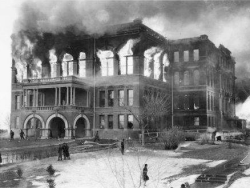Located at the crossroads of the Missouri River and northern transcontinental railroad, Bismarck – or, Edwinton as it was called during its first year – was destined for greatness when the Northern Pacific Railway founded the key city along its rail line in 1872. Early inhabitants sought to prosper on what was predicted to become a major metropolis. Some even hailed it as the “next Chicago.” While Bismarck never evolved into the likeness of Chicago, Bismarck’s colorful history is full of ingenious political maneuvers, innovative entrepreneurs, iconic historical characters, and exceptional prosperity.
The early days of Bismarck were turbulent and lawless, earning such reputations as the “Wickedest City in the West.” Troops, railroad workers, and gold prospectors filled the myriad of saloons, gambling houses, and brothels that lined the streets. Violence was so prominent, particularly along a stretch of Fourth Street, that such derogatory nicknames as “Murderer’s Gulch” and “Bloody Fourth” were once attached to the city. By some accounts, Bismarck averaged 1 murder per day at the time.
By the turn of the century, Bismarck had become established as an important economic, health, and government center. It was named capital in 1883 and gained the territory’s first hospital two years later.
The area was previously home to several dominant native tribes, most notably the Mandan, Hidatsa, Arikara, Sioux, and Chippewa.
La Vérendrye was one of the first outside explorers to the area, around 1738. Explorers Meriwether Lewis and William Clark camped the winter of 1804-1805 at a site roughly 40 miles to the north, along with their Lemhi Shoshone guide, Sakakawea.
Related Content
-
Pre-1871: Early History
Prior to formal organization by the United States Government, the region including and surrounding what is today... -
1871-1872: Establishment
Bismarck was founded as the town of Edwinton in 1872 by the Northern Pacific Railway at the... -
1873-1877: Railroad Arrives, New Name, Panic!
In the year following its founding, 1873 marked several key developments for the fledgling town that were... -
1878-1883: Railroad Completes, Mandan Founded, Bismarck Assumes Capital
The years spanning 1878-1883 were quite possibly the most important in Bismarck’s history, cementing Bismarck’s future as... -
1884-1898: Industry, Statehood, and Fire
Heading into 1884, enthusiasm reigned over Bismarck’s blossoming future, kindled by the long-awaited opening of the Missouri... -
1899-1929: Phoenix: Bismarck’s Rebirth
The 1898 Fire left much of Bismarck in ruin and forced the city to rebuild, propelling Bismarck... -
1930-1945: Great Depression and War
The stock market crashed in October 1929, causing widespread economic chaos across the United States. Hastening local... -
1946-1959: Post-War Boom
Like most cities, Bismarck experienced a massive boom following the end of World War II. Its population... -
1960-1969: Demands Of A Growing City
By 1960, the Bismarck-Mandan micropolitan area had more than 60,000 residents. Education remained a primary growth as... -
1970-1979: Population and Commercial Boom, Evolving Trends
It could be argued that the 1970s left its mark on Bismarck history more than any other... -
1980-1989: Declining Growth
After back-to-back decades of consistent record growth, the boom tapered off in the 1980s. High interest rates... -
1990-1999: Stabilization
The metropolitan population was pushing into 90,000 residents at the start of the decade and exceeds 100,000... -
2000-2009: Reinventing Bismarck
If the 1970s was the decade that left behind the greatest impact, the 2000s was a close... -
2010-Present: Bismarck Today
North Dakota entered the 2010s as the fourth-highest oil producing state in the nation, surpassing California to...



